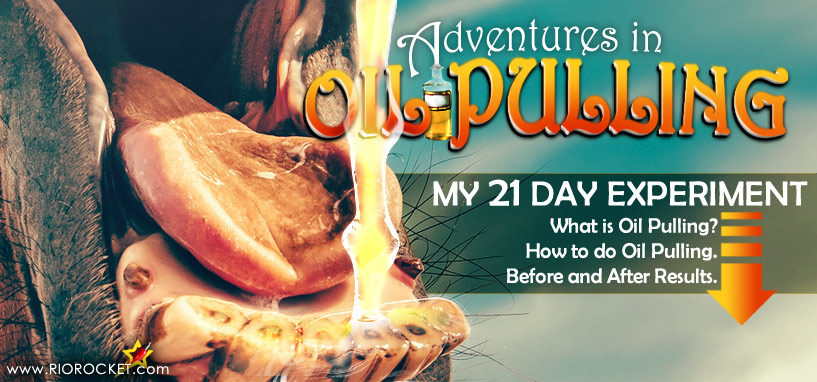
All Graphic Design by Rio Rocket
[dt_divider style=”thin” /]
What is Oil Pulling?
Oil pulling, also called Kavala Graha or Gandusha, is the ancient practice of swishing oils from plants in the mouth for a period of time to draw out oil-soluble toxins and impurities in the body. Oil pulling is one of the five main dental hygiene practices in [dt_tooltip title=”Ayurvedic Medicine”]Ayurvedic medicine (“Ayurveda” for short) is one of the world’s oldest holistic (“whole-body”) healing systems developed more than 3,000 years ago in India. It’s based on the belief that health and wellness depend on a delicate balance between the mind, body, and spirit.[/dt_tooltip] as discussed in the Vedas (Vedic texts).
[dt_divider style=”thin” /]
What is the Purpose of Oil Pulling?
To pull toxins and bacteria from the body that have built up in your mouth. Dentists suggest that by improving [dt_tooltip title=”oral health”]The condition of the mouth, throat, gums and teeth that affect an individuals ability to bite, chew, smile, speak, smile, and swallow. It has tremendous impact on periondontal (gum) disease, tooth decay, tooth loss, other diseases, disorders, and your psychosocial state of well-being.[/dt_tooltip], the health of the entire body is improved.
[dt_divider style=”thin” /]
What are the Benefits of Oil Pulling?
For centuries oil pulling has been used to as a traditional Indian remedy to:
- Whiten teeth
- Cure tooth decay
- Heal bleeding gums
- Reduce inflammation
- Prevent heart disease
- Prevent cavities
- Boost immune system
- Improve acne
- Strengthen gums and jaw
- Sooth dry throat
The [dt_tooltip title=”Journal of Ayurveda and Integrative Medicine“]An open-access, peer reviewed journal published jointly by The Institute of Trans-disciplinary Health Sciences and Technology (TDU) and The World Ayurveda Foundation (WAF), and published on Elsevier.[/dt_tooltip], just recently cited a study that reviewed holistic approaches to oral health which revealed that oil pulling is one of the most effective natural health practices in preventing tooth decay, and even loftier claims of treating more than 30 [dt_tooltip title=”systemic diseases”]A disease affecting the entire body, rather than a single organ or body part. [/dt_tooltip]. See Case Study #1 and Case Study #2 below.
[dt_divider style=”thin” /]
How to do Oil Pulling
The Best Oil Pulling Method for Beginners
- Upon awakening and while on an empty stomach, first hydrate with water.
- Use 1 tablespoon of oil and swish the oil around in your mouth for 15-20 minutes.
- Afterward spit the oil in the trash (it can harden and clog your drain).
- Rinse your mouth with warm salt water.
- Brush your teeth with a toothbrush you DO NOT use daily.
- 30 minutes later brush with the toothbrush you use daily and rinse with mouthwash.
[dt_divider style=”thin” /]
The Best Oils for Oil Pulling
The most popular oils are cold pressed, unrefined, organic virgin Coconut Oil (Case Study #2), Sesame Oil (Case Study #1), Olive Oil, and Sunflower Oil.
[dt_divider style=”thin” /]
Case Study #1: GrandRiver Nick
During my phone conversation with Nick, he pointed out to me that Sesame Oil is considered the most beneficial oil for oil pulling. Nick recommends a variety of oils for the first three weeks such as Sesame Oil, Olive Oil, Palm Oil, and Sunflower Oil. After twenty one days, you can use your favorite oil for oil pulling once a week as maintenance.
Some people may feel queasy or experience headaches as a potential side-effect from the body getting rid of the toxins. Most people should be able to work through it. He told me that after oil pulling for some time he feels his teeth and gums are much stronger.
**WARNING**
Nick warns that if you have the old school [dt_tooltip title=”mercury-amalgam fillings”]Approximately 50% of the composition of dental amalgam fillings, also known as “silver fillings”, is elemental mercury by weight. The chemical properties of elemental mercury allow it to react with and bind together the silver/copper/tin alloy particles to form an amalgam.[/dt_tooltip], you’ll want to have them removed prior to oil pulling to avoid them being stripped and broken down from the oil. He recommends having your dentist do half your mouth first (either the bottom or right side first), and then the other half thirty days later.
30 MINUTE RULE: Oil pulling will trigger your mouth enzymes to create [dt_tooltip title=”amylase”]The enzyme that begins digestion in mouth saliva which converts starch and glycogen into simple sugars.[/dt_tooltip] to begin the digestive process. This happens whenever your bite into anything that’s not water. So thirty minutes after your initial ‘rinse and brush’, you’ll want to brush again with the toothbrush you normally use. This will remove the amylase released into the mouth and prevent it from stripping your teeth of its enamel.
[ninja-inline id=15629]
Case Study #2: The Hungarian Experiment
I also reached out to The Hungarian Experiment, who impressively documented his oil pulling experiment with videos for Day 1, Day 7, Day 11, Day 15, Day 22, and Day 30 on his YouTube Channel. His oil of choice was Coconut Oil.
His Day 22 video is very telling and he’s quite candid about the fact that while maintaining habits of drinking black coffee and smoking during his 30-day oil pulling experiment, his results were still fantastic.
You can watch him do his first oil pulling session in his Day 1 video. Here he writes down on a whiteboard what he is feeling during his first oil pulling session.
Prior to the day of his Day 22 video he had his third cheat day of that month. While oil pulling the day of the video, he pointed out that the oil got unusually thick – forcing him to spit it out after twelve minutes.
He explains that he noticed this during every oil pulling session after a cheat day.
His Day 30 observations video offers findings about the results of oil pulling for thirty days and what science and research say about oil pulling, namely the American Dental Association.
Progress:
After only four days I can say I am noticing increased brightness in my teeth and receding of the gum line. The result of this is that my smile appears slightly fuller and brighter. I will be switching over to Sesame Oil starting Day 5 as per Nick’s recommendation, then to Olive Oil on Day 9, while repeating this cycle until twenty-one days has elapsed. As far as my physical health goes, I feel the same as I have been, so I’ll need at least two to three weeks to gauge whether I feel any overall health benefits. Even if oil pulling primarily benefits oral health then I’d say it’s definitely worth the first twenty minutes of your morning. You can swish the oil around in your mouth while you perform other activities such as checking and sending emails, getting clothes ready for the day, listening to voicemail, etc.
Stay subscribed or Join Today to automatically receive email updates when I post my oil pulling follow-up and other content on peak performance just like this.
[ninja-inline id=15629]
Studies on Oil Pulling
Indian Journal of Dental Research – oil pulling compared to mouthwash
Journal of Clinical and Diagnostic Research – oil pulling with sesame oil
Journal of the Indian Society of Pedodontics and Preventive Dentistry – oil pulling for bad breath
[dt_divider style=”thin” /]
American Dental Association (ADA) – criticism of oil pulling studies
Journal of Ayurveda and Integrative Medicine – oil pulling and tissue regeneration
Seven Research Studies – on oil pulling for promoting oral hygiene
[dt_divider style=”thin” /]






